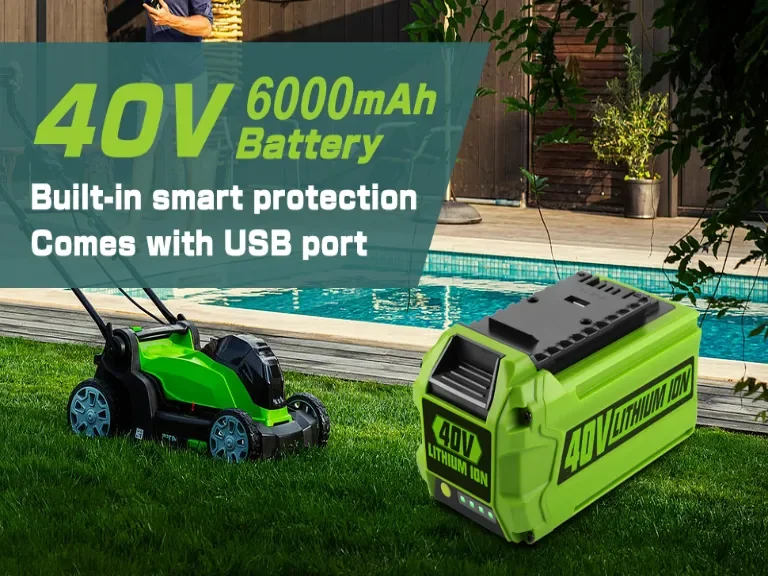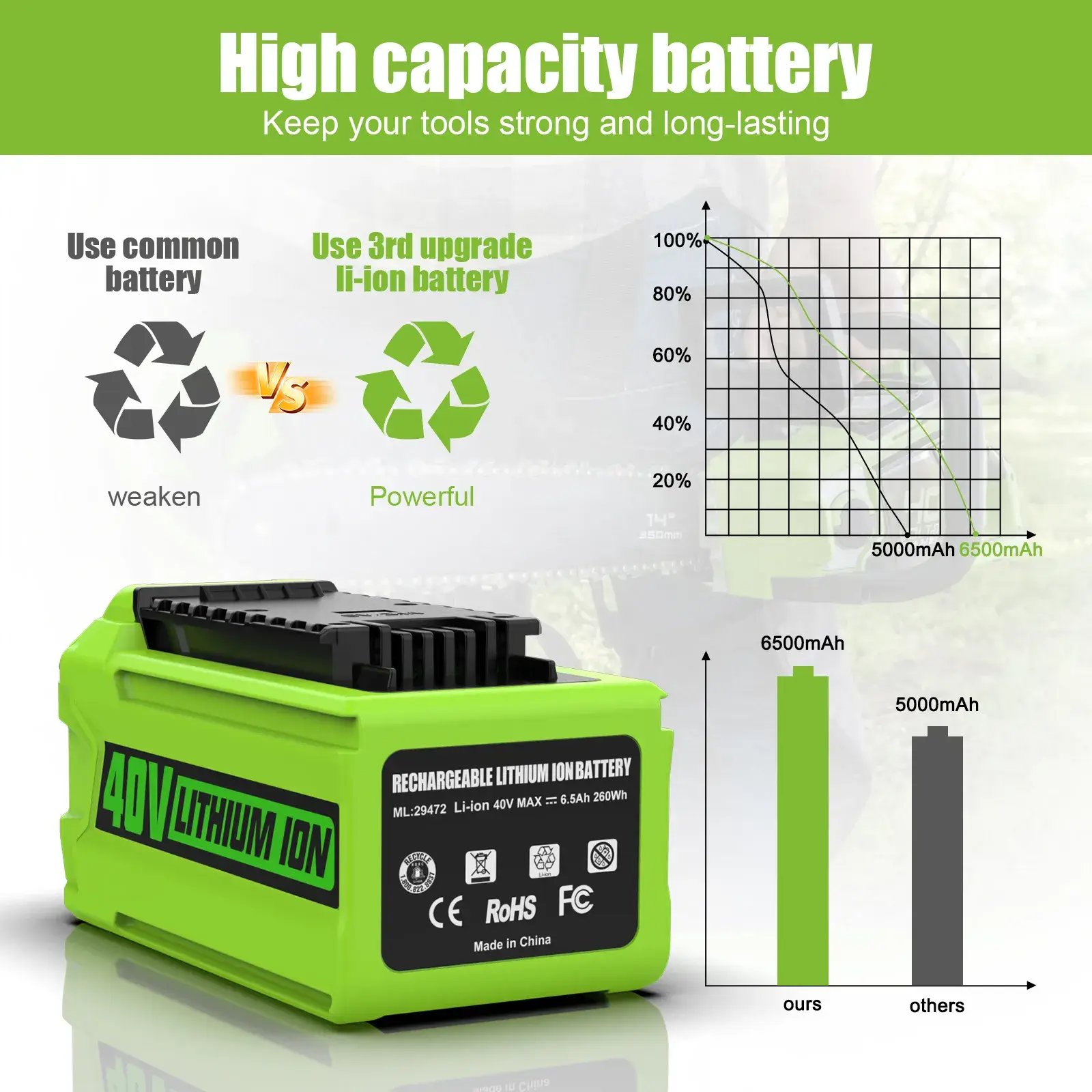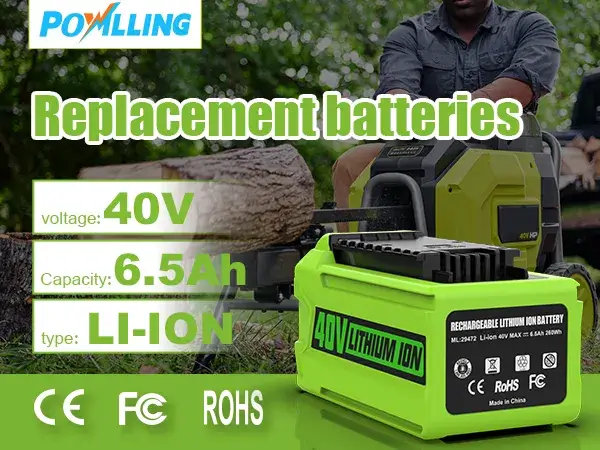Third-Party Garden Tool Batteries Are They Worth the Risk
Cost concerns and supply chain delays have led many buyers to consider third-party batteries for garden tools. While third-party options are significantly cheaper (30-50% savings), they offer up to 600 cycles compared to OEM’s 800-1,000 cycles. The major risks include safety issues like thermal runaway, compatibility problems, and shortened lifespan. To mitigate these, users should ensure the battery meets safety certifications (e.g., RoHS, CE, etc.) and conduct real-world testing.

Third-party garden tool batteries can be worth the risk if chosen carefully. They often cost less and offer comparable performance to OEM batteries. However, quality varies—some may lack proper safety features or void tool warranties. To minimize risk, choose reputable brands with good reviews, certifications (like CE or RoHS), and clear warranty policies. For budget-conscious users, they can be a smart buy when safety and compatibility are verified.
> "Is choosing third-party batteries a budget hack or a risky shortcut?"
> While the lower price is tempting, what are the hidden risks? Understanding the key factors can help you save without sacrificing safety or reliability.

Battery Garden Tools
Why Are People Turning to Third-Party Garden Tool Batteries?
People are turning to third-party garden tool batteries due to their affordability, compatibility with multiple brands, and improved performance options. Many third-party batteries offer similar or higher capacity than OEM versions at a lower cost. They also allow users to power various tools without being locked into one brand’s ecosystem. This flexibility and value make them an attractive alternative for budget-conscious and practical gardeners.
Cost concerns and flexible needs have fueled the rise of aftermarket batteries.
1. OEM Supply Bottlenecks
- In recent years, leading tool brands (like DEWALT and MAKITA) have faced supply chain delays due to chip shortages.
- Stock outages are common during peak seasons, affecting project timelines and landscape maintenance.
2. Increased Cost Sensitivity
- OEM batteries typically cost $120–150, while third-party options are priced between $60–80.
- For teams using hundreds of batteries per month, this can translate into savings of 20–30% annually.
3. Customization and Fast Restocking
- ODM/OEM suppliers offer customized voltage, capacity, and branding, with minimum order quantities as low as 50 units.
- Overseas warehouses (US/EU/CA) ensure emergency sample delivery within 5 days, and bulk orders ship within 20–25 days.
Cost vs Value: A Comparison of OEM and Leading Third-Party Batteries
| Feature | OEM (DEWALT/Makita) | XNJTG Custom Version |
| Unit Price (USD) | $120–150 | $40-80 |
| Cycle Life (Full Charge-Discharge) | 600-700 | 500-600 |
| Warranty | 12 months | 12 months |
| BMS Smart Management | Standard | Standard (Full-Parameter Monitoring) |
| Certifications | CE/ROHS | CE/FCC/KC/RoHS |
| Average Delivery Time (Bulk) | 25–30 Days | 20–25 Days |
> Insight: XNJTG’s full-tab design reduces internal resistance by 30%, providing smoother voltage output and reduced risk of overheating during high discharge usage.

Garden Tools Battery
What Are the Real Risks of Third-Party Batteries?
Here are the top concerns and how to mitigate them:
1. Safety Risks
- Certification Gaps: Lack of FCC, RoHS, CE, or other internationally recognized certifications can result in tool damage and insurance issues.
2. Compatibility Issues
- Communication Protocol Mismatch: if third-party batteries don’t match, the tool may fail to recognize the battery.
- Physical Connector Differences: Loose or misaligned connectors can lead to poor power contact and tool malfunction.
3. Shortened Lifespan and Stability
- Environmental tolerance, like operating in extreme temperatures (–20°C to 60°C), is often a hidden factor—low-quality batteries may experience up to 20% capacity loss in cold conditions.
How Do You Choose the Right Third-Party Battery?
When selecting a battery, it’s not just about price—it's about safety, fit, and support.
| Step | Key Considerations |
| Match Specs | Compare voltage (V), capacity (Ah), and continuous discharge current (A)test discharge curves if needed; |
| Certifications | Ensure CE, FCC, RoHS, etc compliance and request factory test reports. |
| Sample Testing | Order 5–10 sample batteries for real-world testing under various conditions (high/low temperature, long discharges). |
Why Choose XNJTG?
XNJTG stands out in the third-party battery market by offering cost-effective, high-performance alternatives to OEM batteries. Their products are designed to be compatible with various power tools, providing flexibility for users. XNJTG emphasizes safety and reliability, incorporating features like air-cooled charging technology to prevent overheating and extend battery life. Additionally, their global warehousing ensures efficient delivery, making them a practical choice for those seeking quality and affordability in replacement batteries.

Garden Tool Batteries
With so many suppliers out there, why is XNJTG the right choice?
- Advanced Cell Design: Full-tab structure and built-in balancing circuits increase energy efficiency by 10%.
- Global Fast Shipping: Warehouses in the US, EU, and Canada enable emergency deliveries within 7 days.
- Eco-Friendly Practices: XNJTG follows the EU 2024 Battery Directive, offers full carbon footprint reports, and includes WEEE-compliant recycling options.
Case Studies
| Region | Quantity | Delivery Time | Outcome |
| North America | 2,000 units | 15 Days | $45,000 quarterly profit; reduced winter downtime by 40% |
| Germany (Public Parks) | 5,000 units | 20 Days | IP67-rated waterproof packs reduced winter failure rate by 60% |
Frequently Asked Questions
Q1: Will using a third-party battery void my tool’s warranty?
> A: It depends on the tool manufacturer. Some may void the warranty if a third-party battery is used, while others may allow it. Always check the manual or consult the manufacturer.
Q2: How can I verify compatibility with my tool?
> A: Check the connector, voltage, and communication protocol. Request compatibility charts from the supplier or test with small sample orders.
Q3: What warranty does XNJTG offer?
> A: XNJTG provides a standard 12 month warranty, with local returns available in the US/EU.
Q4: Are third-party batteries eco-friendly?
> A: Reputable third-party batteries follow WEEE standards and include recycling programs. XNJTG also offers carbon tracking and eco-friendly packaging.